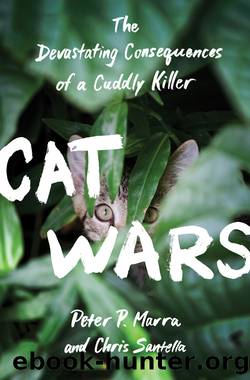Cat Wars: The Devastating Consequences of a Cuddly Killer by Peter P. Marra & Chris Santella

Author:Peter P. Marra & Chris Santella [Marra, Peter P. & Santella, Chris]
Language: eng
Format: epub
Tags: Science, Natural History, nature, Animals, birds, Mammals, Ecosystems & Habitats, General, Life Sciences, Zoology, ornithology, Pets, Cats
ISBN: 9781400882878
Google: 7TD9CwAAQBAJ
Publisher: Princeton UP
Published: 2016-08-29T20:36:31+00:00
In Australia a very different ethos is guiding free-range cat management strategies, as government officials rally to save a host of endangered endemic species from extinction.
Domestic cats arrived on the Australian Continent with European visitors, perhaps as early as the seventeenth century (with shipwrecked Dutch sailors) and most certainly by the late eighteenth century when the English began their colonization efforts. (Australia, like Antarctica, does not have any native members of the cat family, Felidae.) By the mid-nineteenth century, feral cat colonies were well established throughout most of the continent, with the exception of wetland rain forests and some offshore islands. Additional cats were intentionally introduced on the continent in the late 1800s in hopes of reducing populations of nonnative rabbits, rats, and mice.
Cats, as has been noted, are highly effective predators, and in the course of several hundred years they have had a significant impact on Australiaâs indigenous fauna and, ironically, no impact on its populations of nonnative rabbits, rats, and mice. In fact, a number of small mammals (the Australia Department of the Environment places the number at twenty-seven) and several species of ground-dwelling birds have gone extinct, thanks in large part to cat predation. Predation by foxes, another introduced species, has undoubtedly also contributed to the problem. âMany Australian mammals were easy prey for feral cats and foxes,â said Dr. John Woinarski, a professor at the Research Institute for the Environment and Livelihoods at Charles Darwin University, who has been involved in research, management, advocacy, and policy relating to biodiversity conservation, particularly in relation to threatened species. âBefore their introduction, there were no comparable native predators. All the mammals that went extinct were small, shy, nocturnal creatures like the desert bandicoot, a small rodent-like animal that was distributed through central Australiaâs arid regions. People didnât really appreciate them, as they werenât very aware of them. It didnât help that these animals had low reproductive rates.â8
The connection between feral cats and these Aussie extinctions has been made most forcefully by Dr. John Wamsley, known in some circles as the âcat hat man.â Beginning in the early 1970s, Wamsley would show up at public events wearing a hat fashioned from the pelt of a feral cat and fronted by the animalâs face. He recalled in a 2005 interview that some animal liberationists had pointed out that it was illegal for him to do anything about the feral cats that were destroying wildlife on his land, and they would take action against him if he did soâso he had to change the law. His cat hat statement certainly attracted attention; in the same interview, he recalled, âI knew exactly what newspapers had reported it, by where the death threats were coming from.â9
âWamsley is a bit of a crank in some ways, but heâs certainly charismatic,â Woinarski said. And Wamsleyâs commitment, Woinarski acknowledged, has gone beyond controversial headgear. âHe built some enclosures designed to keep cats and foxes out so native animals could live without these invasive predators. These experiments in creating a cat-free environment showed that the native animals could thrive without predators.
Download
This site does not store any files on its server. We only index and link to content provided by other sites. Please contact the content providers to delete copyright contents if any and email us, we'll remove relevant links or contents immediately.
Sapiens: A Brief History of Humankind by Yuval Noah Harari(14321)
The Tidewater Tales by John Barth(12626)
Mastermind: How to Think Like Sherlock Holmes by Maria Konnikova(7279)
Do No Harm Stories of Life, Death and Brain Surgery by Henry Marsh(6905)
The Thirst by Nesbo Jo(6881)
Why We Sleep: Unlocking the Power of Sleep and Dreams by Matthew Walker(6657)
Life 3.0: Being Human in the Age of Artificial Intelligence by Tegmark Max(5516)
Sapiens by Yuval Noah Harari(5324)
The Longevity Diet by Valter Longo(5042)
The Body: A Guide for Occupants by Bill Bryson(5030)
The Rules Do Not Apply by Ariel Levy(4910)
The Immortal Life of Henrietta Lacks by Rebecca Skloot(4550)
Animal Frequency by Melissa Alvarez(4428)
Why We Sleep by Matthew Walker(4394)
The Hacking of the American Mind by Robert H. Lustig(4339)
Yoga Anatomy by Kaminoff Leslie(4333)
All Creatures Great and Small by James Herriot(4271)
Double Down (Diary of a Wimpy Kid Book 11) by Jeff Kinney(4242)
Embedded Programming with Modern C++ Cookbook by Igor Viarheichyk(4141)
